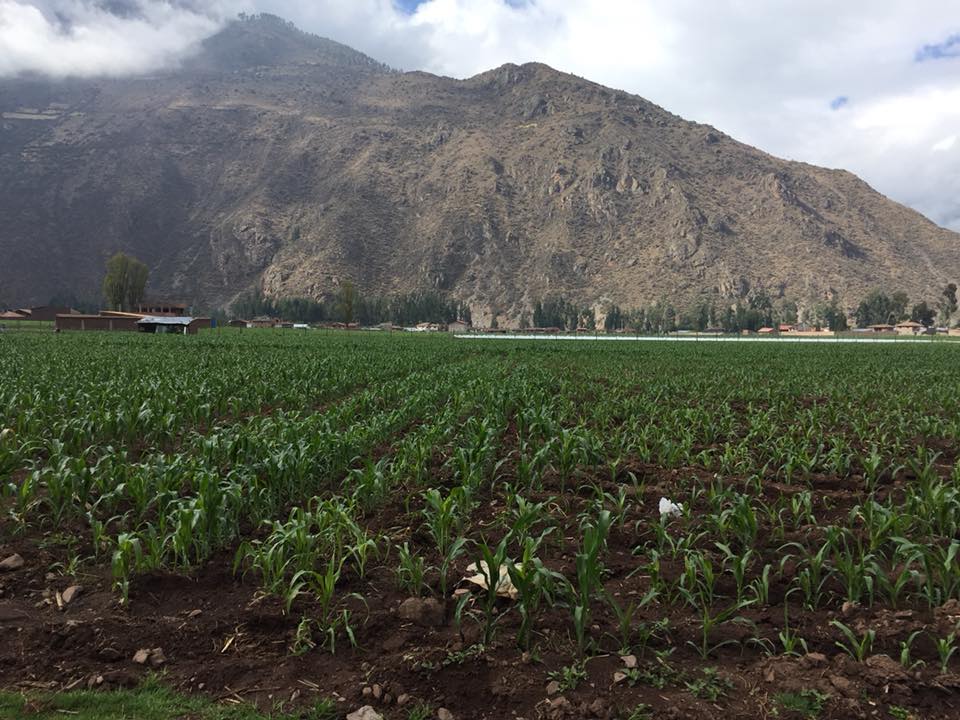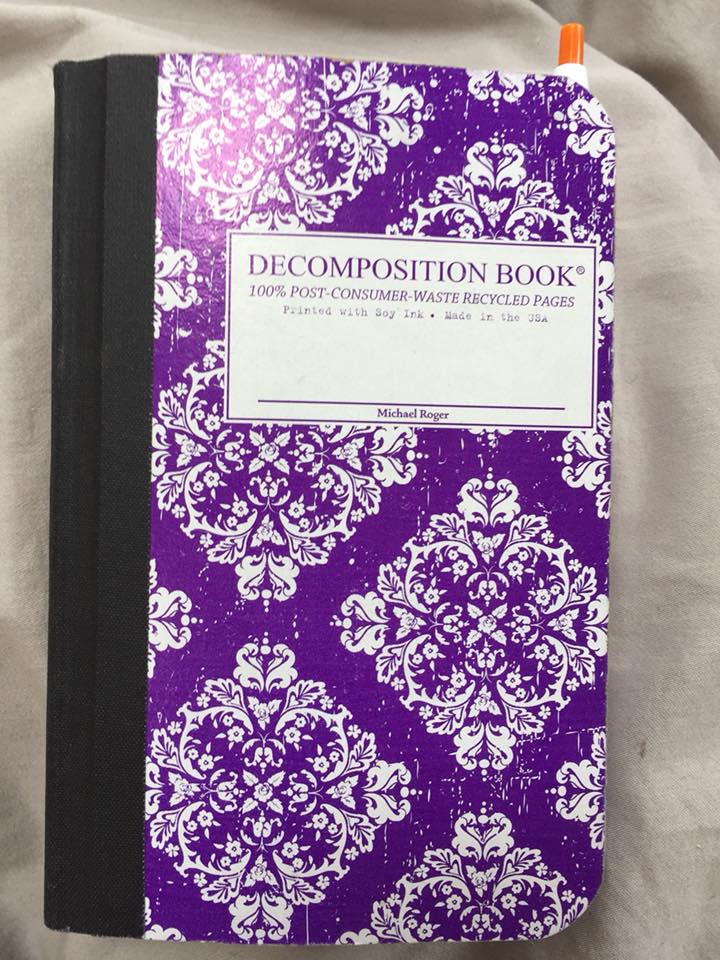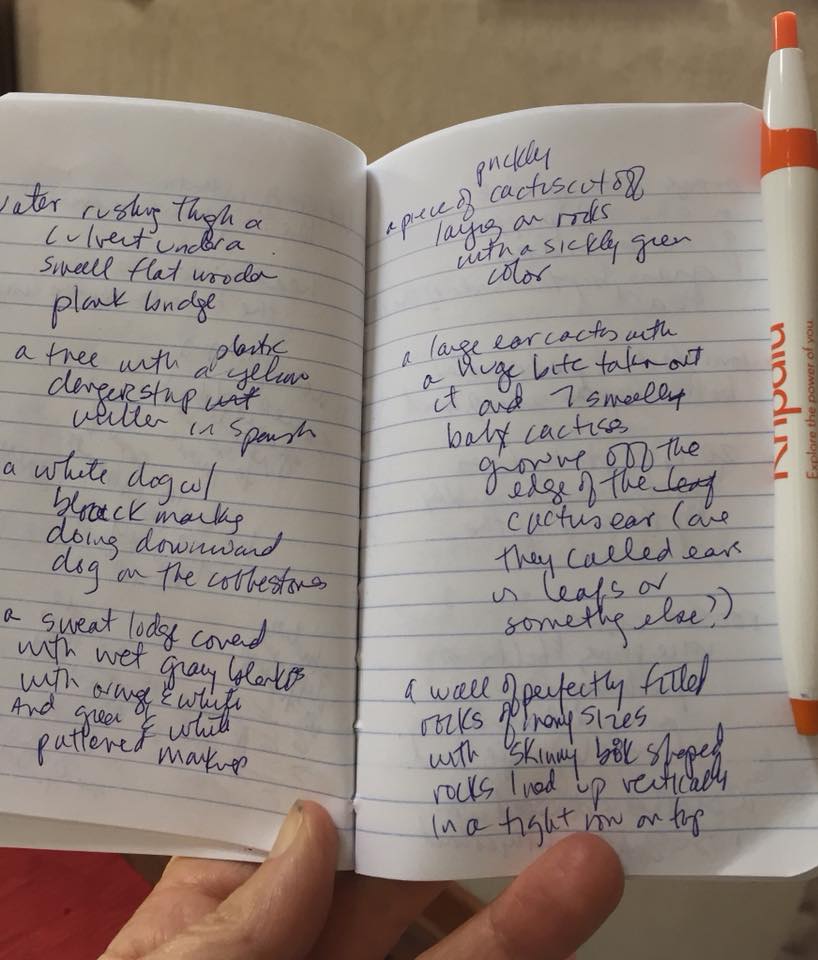Yesterday I went on a morning walk through the neighborhood around Sach’a Munay and I shared it here with you through photos of my journey. This morning, I decided to head out in the same direction, but this time I wanted to take the walk as a writer. This is one of the first skills I’ll be teaching my students when they arrive here on Wednesday—how to walk through the world as a writer, rather than just as a garden variety tourist.
The first step in traveling as a writer is to go out alone (or if you go out with a partner, to go in silence and to not stick too closely together) and to bring a small hand-size notebook.
These notebooks are the very first gift I give my writing students on the first day of any Write, Travel, Transform trip. They’re back pocket size, purse size, fanny-pack size, but big enough to take substantial notes in. I break out a new one for every trip, and usually fill two or three in the course of a three-week trip. I jot down everything from card game scores to directions to names I’m trying to remember to place names to notes on outings to facts from guides.
This morning, I headed out in the foggy moist early morning on the dirt and rock/path out of Sach’a Munay with my little notebook and a pen, several layers covering my torso, a rain jacket for the grey clouds overhead, the same jeans I’ve worn for the past four days, and sneakers. I tucked my iphone in the back pocket of my jeans because I knew I wanted one photo to frame this blog post. But I also knew I wasn’t going to lead with my phone/camera because I was taking this walk as a writer–so it was my notebook and pen, not a camera, I held in my hand as I walked. If I saw something noteworthy, I wasn’t going to whip my camera out. I was going to pull out my pen and describe it with words.
I didn’t have a destination. I set out wandering, taking a different fork in the path than I did yesterday. I tried to remember landmarks along the way so I wouldn’t get lost, but mostly I sought to aimlessly wander.
It was a little after 7:00 AM when I set out and the village I wandered through were still pretty sleepy. I walked with all my senses open—looking at textures and colors and houses and dogs and doorways and garbage—everything I could see. I noted smells and sounds. And I jotted it all down in my little notebook, stopping frequently when anything drew my attention. I don’t know what the locals thought of me, a white woman with a bright green expensive rain coat, writing in a little notebook, but I walked on.
This kind of sensory writing walk is the first step in building a library of sensory detail that can later be pulled into a story or a vignette or a blog post—making it vivid and alive for the reader. People often read my travel blog and say, “I felt like I was there.” And this is why. It’s all those sensory details, carefully harvested and planted.
At first, I don’t look for a story. I just notice what’s in front of me. If a story comes along, I don’t turn it down, but first, I’m just on the prowl for pure sensory detail. And when I find something odd or quirky, all the better. Those kind of odd details are the best, but ordinary details are fine, too.
I also noted things I was curious about—often with a question mark. Curiosity is a travel writer’s best friend. Occasionally I noted a thought or a feeling, but 95% of what I wrote was pure observation.
Here’s a sampling of what I jotted down this morning, scrawled across the pages of my little lined book:
Water rushing through a culvert under a small flat wooden plank bridge
A tree wrapped with a strip of plastic yellow crime scene tape written in Spanish.
A white dog with black markings doing downward dog on the cobblestones.
A sweat lodge covered with wet gray blankets with orange and white and green and white patterned markings
A piece of prickly cactus cut off lying on rocks with a sickly green color
A large ear cactus with a huge bite taken out of it and 7 small baby cactuses growing off the edge of the cactus eat (are they called ears or leaves or something else?)
A wall of perfected fitted rocks of many sizes with skinny book shaped rocks lined up vertically in a tight row on top, just like books on a shelf.
Orange seed pods and a chunk of puffed quinoa? in dry grass by the side of the road
Torn plastic and plastic water bottles by the side of the road
20 bald dirty tires stacked haphazardly by the side of the path
Roosters crowing
Voices rising and falling in Spanish from a small mud house off the side of the road
A clothesline draped with soggy brightly colored clothing
A huge fancy wooden gate with a locked door and doorbell high up on the right. Is this where the richest person in town lives?
5 pound yellow bags of 50 kg Azucar refinado (white refinded sugar) with rocks piled on top. Are the bags being recycled? What’s in them?
The two dogs who have been following me pooping simultaneously
Flattened tin can and plastic cup and a squashed plastic bottle on the path alongside a huge corn field
I’m walking on a grassy path studded with rocks
Man in an orange vest and orange cap working in an immense corn field, surrounded by mountains on all sides and white and grey morning fog
A dried shriveled corn husk lying on the grass between two fields of corn
The end of the path and three dogs barking fiercely turned me around
Giant black charred burl in the grass by the corn field
The sensation of dampness seeping through my sneakers
A large blue and white Pall Mall banner ad on the side of an unfinished mud brick wall
The sound of running waters
The sound of cows mooing
A fork off the aqueduct flowing at a right angle directly into the corn field
A soft “Buenos Dias” in response to my morning greeting
Memories of my father setting off on early morning solo walks whenever we were in a new place
Man working in a corn field with a hoe with a hand-hewn handle
A thick black puppy with tan feet
Two women walking with brightly colored striped shawls, one with a toddler tucked in on her back
Stacks of boards by a brick building—the sound of power saws and Spanish radio coming out of the shop. I peek inside—it’s a furniture shop
A man polishing a shiny black van with a white cotton cloth—it has Peru license plates.
Smell of manure
Light wind in my hair
Warming sun—time to peel off layers
Bags of boric acid leaning against a house
Sound of hammers and a kitchen timer dinging
A field covered with white plastic with symmetrical holes in it so the dirt—and eventually seedlings—can poke through
Curved corrugated silver metal door with rusty bottle caps riveted or hammered in to hold the wood of the frame in place
Two men on a scooter…memories of Laos, Cambodia, Vietnam and Bali
Man standing so still in a field I thought he was a scarecrow
A balding man carrying a little girl on his shoulders came toward me on the narrow path. I stepped aside to let them pass. “Muchas gracias” was his reply.
A woman carried a yowling cat in a striped plastic bag, the only cat I’d seen in a sea of dogs
Question: Why am I only seeing corn fields? Where’s the quinoa? Of course, I have no idea what it looks like.
And later: a field with green foliage and purple flowers. Are these potatoes?
I think you get the idea. I spent over an hour doing this. On my way back, I noticed different things than I did on my way out because I had a different point of view. Also, it was close to nine AM on my return and there were many more conversations wafted out of houses and little shops and more people at work. Mostly, I saw lots of people doing hard physical labor—lifting bricks, making walls, tiling fields, carrying loads. In this way, Peru feels very much like other third world countries I’ve visited.
I was glad I was only taking notes—what right do I have to take photos of people going about their daily lives? Would I want tourists taking pictures of me as I go about my daily life at home?
And here’s where the story comes in: It was after I came out of the long dirt and stone path up from the massive corn field that I came to a fork in the path that I didn’t recognize. I wasn’t sure which way to go. That’s when I felt my first little twinge of anxiety. I took the right fork first and I kept looking for landmarks—both on the sides of the road and even in the kinds of trash thrown on the ground, but nothing looked familiar. Finally, I came to a dirt T intersection that I definitely hadn’t seen before, so I backtracked back to the fork and took the other pathway, but after a while and a few more turns (me, trying to recall each turn carefully), I suddenly realized that I didn’t know where I was. I was lost.
That word: LOST clutched me in the gut and I had a rush of fear. I’m LOST! But less than a minute after that, seconds later actually, I remembered the time I went out in the early morning in Laos and crossed a swinging bridge to walk through a neighborhood with no tourists, and I got lost there too—but I’d found my way back eventually that time and had a blog post to show for it.
I stopped. I breathed. I looked around me. And then I knew the real truth: I’m not lost. I’m right here. How can I be lost when I am where I am? Standing on this pathway in a beautiful village in the Sacred Valley of Peru.
I didn’t know how to get back to Sach’a Munay, it was true, but I wasn’t lost. I was standing on sacred ground. I was breathing. My body felt good moving. The people around me were warm and welcoming. It was daylight. I could figure this out. I didn’t have a roomful of students waiting for me. Karyn might wonder where I was, but I didn’t think she’d really worry.
Then I remembered the phone in my back pocket. I opened Google Translate and asked for the Spanish translation of “Where is Sach’a Munay?” And instantly there it was, “Donde es Sach’a Munay?” My many failed attempts to learn Spanish came back to me and I smiled. Oh yeah, that’s how you say it. So, I continued up the path. The first person I met was a girl carrying a large piece of firewood in her arms. “Buenos dias. Por favor, donde es Sach’a Munay?” She gestured to the left and let out a flurry of Spanish I couldn’t understand a word of. But I walked alongside her for a while and when we came to the next intersection, she gestured again to the left and we parted. Soon after I came to another man and repeated my question. He gestured to the left and the right and I followed his directions.
Then I asked a third man. Everyone in this neighborhood knows Sach’a Munay. The retreat center employs lots of local people and pays a decent wage. They do a lot to support the local community. They all knew what I was asking, despite my pitiful Spanish.
Pretty soon, just ten minutes after the realization that I was “lost,” there was the graveyard from my walk yesterday on my left! Suddenly, I knew just where I was and I walked with more confidence, carrying my cashmere cardigan and bright green Patagonia rain jacket over my arm. I was sweating and tired, but my step quickened. My fear transformed into pride as I tromped the ten minutes back up the hill past familiar landmarks to breakfast.
My forehead was beaded with sweat and I’d been gone a lot longer than I intended, but I felt triumphant. I wasn’t lost. I was found. I’d gone for a walk as a writer. I was back in my groove again.
And a few days from now, my students, too, will be venturing out with their little notebooks, taking in life and the Sacred Valley as only writers do.

The big corn field, the mountains and the mist.

Peru notebook #1.

Here’s what my notes look like. I took ten pages of notes on my walk this morning.
